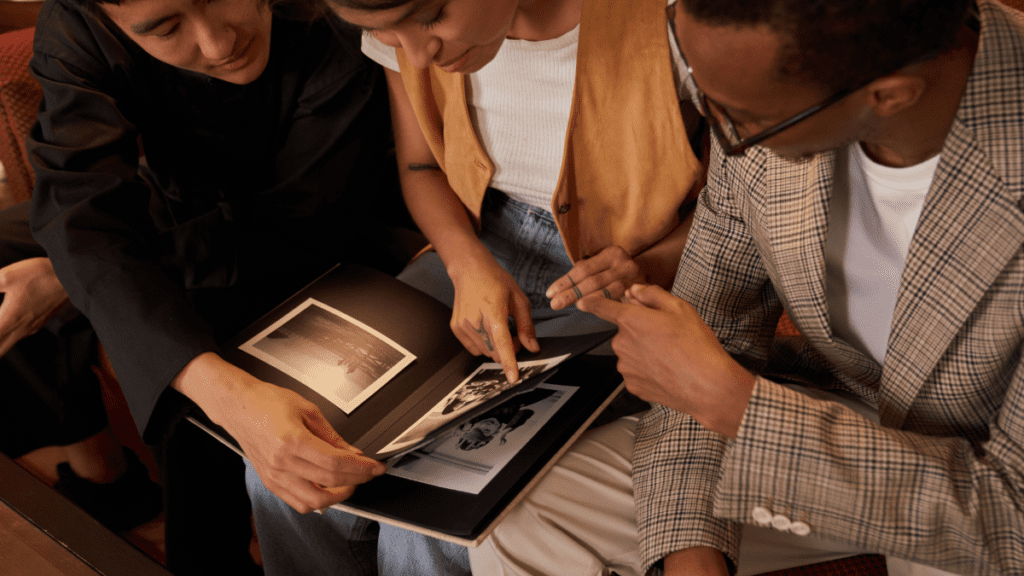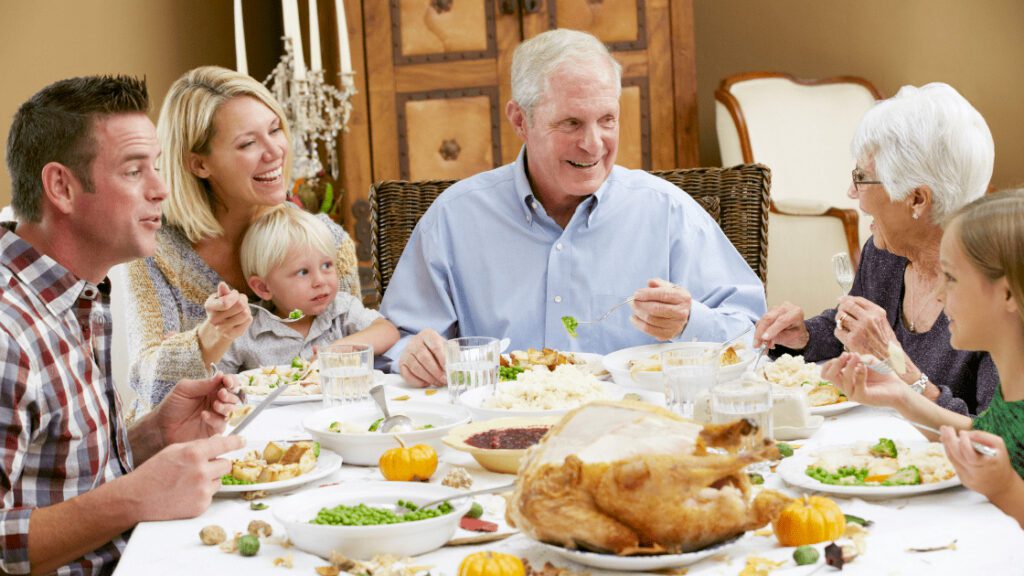Could honoring your ancestors as part of your Thanksgiving celebration be a new tradition to add to your family gatherings? Remembering the ancestors who have passed down stories, traditions, recipes, values, and traits is a great way to show heartfelt gratitude for the many blessings we enjoy. Acknowledging the contributions they have made to our history, culture, and identity is a legacy worth passing around the family table on a day dedicated to giving thanks.
In this article, we will explore 10 meaningful ways to incorporate ancestral remembrance into your Thanksgiving celebrations. These ways will help you pay tribute to your ancestors and connect with your heritage. They will also help you create new family traditions and lasting memories. Whether you have a rich or a vague knowledge of your ancestry, whether you have a large or a small family, whether you celebrate Thanksgiving traditionally or creatively, these ways will inspire you to honor your ancestors on this special holiday.
Documenting Your Ancestors’ Final Resting Place
One way to honor your ancestors on Thanksgiving is to visit their final resting place and document it. This can be a meaningful way to preserve cemetery information and show respect to your deceased relatives. You can also learn more about your family history and genealogy by exploring the cemetery.
A valuable tool that can help you document your ancestors’ final resting place is the BillionGraves app. This app allows you to take photos of gravestones and upload them to a database that can be accessed by other researchers and family members. The app also uses GPS technology to map the location of each gravestone and link it to other records.
Here are the steps to document your ancestors’ final resting place using the BillionGraves app:
- Download the app from Google Play or App Store and create a free account.
- Find the cemetery where your ancestors are buried using the app’s search function or map feature.
- Take photos of each gravestone using the app’s camera function. Make sure the photos are clear and legible.
- Upload the photos to the app’s database using the app’s upload function. Make sure you have a good internet connection.
- Review and edit the photos using the app’s website or transcription tool. You can add names, dates, relationships, or other information to each photo.
- Share the photos with your family members or other researchers using the app’s share function. You can also download or print the photos for your personal use.
By documenting your ancestors’ final resting place, you can honor their memory and legacy on Thanksgiving.
Carrying Forward Ancestral Thanksgiving Traditions
Another way to honor your ancestors on Thanksgiving is to continue or revive their Thanksgiving traditions. This can be a wonderful way to celebrate your family customs and heritage over generations. You can also feel closer to your ancestors by following their footsteps and honoring their wishes.
One example of an ancestral Thanksgiving tradition is setting an extra place at the table for a departed loved one. This tradition originated from the Irish immigrants who came to America in the 19th century. They believed that setting an extra place at the table would invite their deceased relatives to join them in spirit and bless them with good fortune.
Another ancestral Thanksgiving tradition could be the breaking of the turkey wishbone. This tradition originated from the ancient Romans who believed that chicken bones had magical powers. They would dry the bones and break them with another person while making a wish. The person who got the larger piece would have their wish come true. Hungry for more wishbone history? Check out the video below.
These are just a couple ideas for ancestral Thanksgiving traditions that you can carry forward on this holiday. You may have other traditions that are unique to your family or culture that you can continue or revive as well!
Savoring Ancestral Flavors
A third way to honor your ancestors on Thanksgiving is to prepare and share their dishes on this holiday. This can be a delicious way to enjoy your family recipes and heritage. You can also learn more about your ancestors’ lives and tastes by savoring their flavors.

One example of a cherished ancestral dish is cornbread dressing. This dish originated from the Southern states of America where corn was abundant and cheap. Cornbread dressing is made with crumbled cornbread, bread crumbs, eggs, butter, broth, celery, onion, sage, thyme, salt, and pepper. It is baked in a casserole dish and served with turkey gravy.
Another familiar heritage dish is cranberry sauce. This dish originated from the Native Americans who used cranberries as food, medicine, and dye. Cranberry sauce is made with fresh or canned cranberries, sugar, water, orange juice, orange zest, cinnamon, nutmeg, and cloves. It is cooked in a saucepan until thickened and served with turkey or ham.
Quiz your friends and relatives about other dishes that you can savor on Thanksgiving. Are there recipes that are special to your family or heritage that you can prepare and share? If your family doesn’t have a specific tradition, perhaps introducing a new heritage recipe that can be passed down through the generations can be the legacy you bring to the lineage! Move on to tradition #4 to find out how.
Exploring Unknown Ancestral Culinary Heritage
A fourth way to honor your ancestors on Thanksgiving is to discover and try their dishes that you may not be familiar with. This can be a challenging but rewarding way to expand your culinary horizons and heritage. You can also gain a deeper appreciation of your ancestors’ cultures and cuisines by exploring their unknown flavors.
Don’t know your ethnic origins? To discover more about your ancestral culture and cuisine, you could start by taking a DNA test to identify ethnic origins. A DNA test reveals your genetic makeup and ancestry by analyzing a saliva sample. Once you have that information, you can research the native lands and foods of your ancestors based on your results.
Another method for investigating your cultural and ethic background and food traditions is to use online resources. Websites like Ancestry and MyHeritage offer vast databases, historical records, and collaborative platforms to help you trace your family’s lineage. With these resources, you can explore birth, marriage, and death certificates, census records, immigration documents, and more, providing valuable clues about your family’s origins. Both sites offer a few free tools with limited access so you can try the service out before committing. Check out our blog post Best Tools for Genealogy Research, Writing, and Organizing for more ideas.
Finding Heritage Recipes
If you already know your ethnic background but want to explore cuisine more deeply, here are some places to find heritage recipes to try:
- Taste of Home: This site acknowledges that special recipes are at the heart of so many of our warmest memories. Easily searchable and offering fully-tested recipes from a network of home cooks that are passionate about food and entertaining, this site also has great recipe compilations like this: 50 Heritage Dinners Your Family Will Love.
- Food.com: This is a website that helps you find and share recipes from around the world. You can also browse recipes by cuisine, healty/diet, ingredient, occasion/season, and popularity.
- Allrecipes.com: This is a website that helps you find and share recipes from home cooks like you. Browse recipes by cuisine, occasion, or ingredient, and get kitchen tips to up your culinary skills.
By exploring your ancestral culinary heritage, you can honor the diversity and complexity of your family line.
Expressing Gratitude for Ancestral Contributions
A fifth way of honoring your ancestors on Thanksgiving is to express gratitude for their contributions to history and society. This can be a respectful way to acknowledge their roles and achievements in shaping our world. You can also learn more about their struggles and successes by expressing gratitude for their contributions. Ask older relatives to share contributions that the builders, artists, teachers, professionals, religious leaders, and even notorious characters that make up your family lineage may have made in their lifetimes.

One example of an ancestral contribution is the military service. Many of our ancestors have served in the military during various wars and conflicts in history. They have fought for our freedom, security, and peace. They have sacrificed their lives or limbs for our country and our future.
Stumped for ideas? If you don’t have a particularly well-known family contribution to explore, try acknowledging things closer in time. Was your grandfather a mason that contributed to a beautiful local building or landscape? Did your great-aunt raise a widowed sibling’s children after a tragedy? Maybe your great-grandfather had a love for gambling that led him to invent a cool slot machine. Or what about that distant cousin who is an accomplished musician? Finding and highlighting small stories, even if they are tinged with heartbreak, can speak to the amazing accomplishments, resilience, and love your ancestors have exhibited.
These are just a couple ways of honoring your ancestors by acknowledging contributions on Thanksgiving. By creating a tradition of sharing how your ancestors lived, you are also contributing to a sense of identity and family heritage that future generations can benefit from!
Passing Down Ancestral Stories
A sixth way to honor your ancestors on Thanksgiving is to tell and listen to their stories. This can be a valuable way to connect generations and preserve family history. You can also learn more about yourself and your roots by passing down ancestral stories.

One example of an ancestral story is the immigration story. Many of our ancestors have immigrated from different countries or regions to America in search of a better life. They have faced various challenges and opportunities in their journey. They have brought with them their cultures, languages, traditions, and values.
Another example of an ancestral story is the love story. Many of our ancestors have met and married their spouses in different ways or circumstances. They have experienced various joys and sorrows in their relationship. They have created and nurtured their families with love.
One modern way to pass down ancestral stories is to record them using audio or video devices. You can then preserve them in digital or physical formats for future generations. Have a family member that loves to write? Ask them to collect stories through notetaking or online tools. That allows them to be saved and included in books or websites for others to read.
Embracing a Slower Pace on Thanksgiving
A seventh way to honor your ancestors on Thanksgiving is to take a break from the hustle and bustle of daily life and embrace a slower pace for the holiday. This can be a refreshing way to enjoy simple pleasures and appreciate what we have. You can also feel closer to your ancestors by living more like they did.
One example of embracing a slower pace on Thanksgiving is to disconnect from technology and reconnect with nature. You can turn off your phone, computer, TV, or other devices and spend some time outside and enjoy the fresh air, sunshine, or breeze. Get out and admire the beauty of nature. Engaging in outdoor activities, such as hiking, biking, gardening, or playing are also lovely ways to savor this holiday.
Spending quality time with family cooking, having meaningful conversations, sharing stories, reminiscing, or offering support to those in need. You can also have fun together, play games, watch movies, or listen to music.
By embracing a slower pace on Thanksgiving, you can honor your ancestors who lived simpler and slower lives than we do today. This can provide more peace, joy, and gratitude in your life.
Inheriting Ancestral Character Traits
An eighth way to honor your ancestors on Thanksgiving is to reflect on and appreciate the genetic characteristics and character traits that you have inherited from them. This can be a fascinating way to discover more about yourself and your roots. You can also understand more about your own strengths and weaknesses by reflecting on inherited traits.
Some characteristics that are passed down from parent to child in humans include: eye color, hair color and texture, skin tone, blood group, freckles, color blindness, dominant hand, dimples, earlobe attachment, and hairline shape.

One way to reflect on and appreciate these inherited traits is to compare yourself with relatives across generations. Look at photos, videos, documents, or records of your ancestors and see if you can spot any similarities or differences in their appearance, expression, or posture. You can also ask your family members or friends if they can notice any resemblances or contrasts between you and your ancestors. This can be a really fun way to get to know more about yourself and the people who have gone before.
Familial Character Traits
Discussing familial character traits is also a way of honoring your ancestors on Thanksgiving. Character traits are the qualities or attributes that define a person’s personality, behavior, or attitude. Character traits can be inherited through genes or learned through environment. Some examples of character traits are:
- Courage: The ability to face fear, danger, or difficulty with bravery and confidence.
- Honesty: The quality of being truthful, sincere, and trustworthy.
- Creativity: The skill of producing original, novel, or innovative ideas or solutions.
- Loyalty: The feeling of devotion, fidelity, or allegiance to someone or something.
- Humor: The sense of finding or creating amusement, laughter, or fun.
Another way to reflect on and appreciate your ancestral character traits is to take personality tests or quizzes that can reveal your traits based on your answers. You can then compare your results with those of your ancestors if they have taken the same tests or quizzes. You can also research the meaning and origin of your traits based on your heritage.
By exploring and appreciating the genetic predispositions and common character traits inherited from your ancestors, you are honoring their influence and legacy.
Capturing Generational Moments
A ninth way to honor your ancestors on Thanksgiving is to capture photos of your family members across generations. This can be a memorable way to preserve family history and create family heirlooms. You can also learn more about your family’s changes and continuities by capturing generational moments.
Generational photos are photos that show family members from different generations in the same frame. They can capture the physical resemblance, emotional bond, or historical context of the family members. This type of family photo can also show the diversity, complexity, and richness of the family’s heritage.
Generational Photo Ideas
- Multiple-generation photo: A photo that shows multiple generations of family members in one shot.
- Sibling photo: A photo that shows siblings from the same generation in one shot.
- Cousin photo: A photo that shows cousins from the same generation in one shot.
- Chosen family members: Many families have cherished friends that become part of the family and share in celebrations like Thanksgiving. Include them in a special image.
- Pets: Have multiple generations been pet lovers? Include family pets in a generational photo.
One easy way to capture generational photos is to use a tripod or a timer to set up the camera and pose with your family members. You can also ask someone else to take the photo for you. And of course, taking a selfie using a smartphone or a tablet, as well as using apps or filters to enhance the photos is a popular way to snap shots on Thanksgiving.
Preserving Family Photo Heritage
The tenth and final way to honor your ancestors on Thanksgiving is to label and preserve old family photos. This can be an important way to protect family memories and pass them on to future generations. You can also learn more about your ancestors’ lives and personalities by preserving family photo heritage.
Family photos are precious documents that capture moments in time and space of our ancestors. They can reveal details such as names, dates, places, events, relationships, or emotions of our ancestors. Family photos can also evoke feelings such as nostalgia, curiosity, or admiration for our ancestors.
Preserving family photos is important not only because they can be fragile and may fade or become damaged over time, but also because it is easy to forget details if they are not labeled or preserved properly.
Methods for Preserving Photos
- Labeling: Writing information on the back or front of the photo using a soft pencil or a special pen. The information can include names dates places events relationships or stories related to the photo.
- Scanning: Creating digital copies of the photo using a scanner or a camera. The digital copies can be stored on a computer phone cloud service or external drive. The digital copies can also be edited or enhanced using software or apps.
- Organizing: Sorting and arranging the photos by categories such as family name generation date place event or theme. The photos can be organized in boxes binders albums or frames.
- Sharing: Distributing or displaying the photos to family members or friends using various platforms such as email text social media website or blog. The photos can also be printed or published in books or magazines.
By preserving family photo heritage on Thanksgiving, you can honor your ancestors who have left behind their images and impressions for you. Grab additional ideas and learn more about the history of family photos in our post The Evolution of Family Photo Traditions.
In this article, we have explored 10 meaningful ways to honor and remember your ancestors on Thanksgiving. These ways are:
- Documenting your ancestors’ final resting place.
- Carrying forward ancestral Thanksgiving traditions.
- Savoring ancestral flavors.
- Exploring unknown ancestral culinary heritage.
- Expressing gratitude for ancestral contributions.
- Passing down ancestral stories.
- Embracing a slower pace on Thanksgiving.
- Reflecting on inherited genetic and character traits.
- Capturing generational moments.
- Preserving family photo heritage.
By incorporating traditions like these into your Thanksgiving celebrations, you can pay tribute to your ancestors and connect with your heritage. It doesn’t matter if you have a rich or a vague knowledge of your ancestry, if your family is large or small, or if you celebrate Thanksgiving traditionally or creatively, these ways will inspire you to honor your ancestors on this special holiday.
Drop a comment to share your own ancestral Thanksgiving traditions and stories with us!


